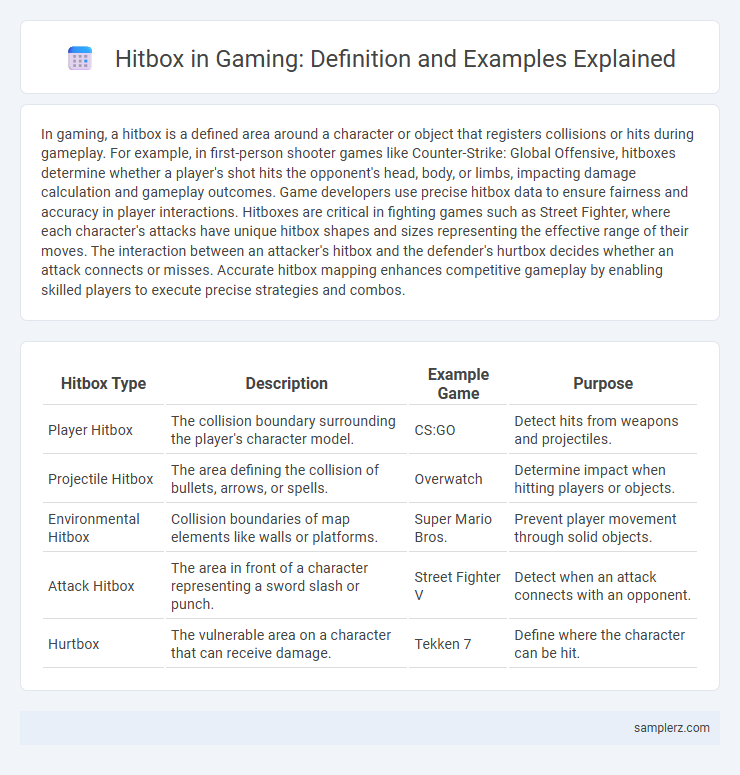In gaming, a hitbox is a defined area around a character or object that registers collisions or hits during gameplay. For example, in first-person shooter games like Counter-Strike: Global Offensive, hitboxes determine whether a player's shot hits the opponent's head, body, or limbs, impacting damage calculation and gameplay outcomes. Game developers use precise hitbox data to ensure fairness and accuracy in player interactions. Hitboxes are critical in fighting games such as Street Fighter, where each character's attacks have unique hitbox shapes and sizes representing the effective range of their moves. The interaction between an attacker's hitbox and the defender's hurtbox decides whether an attack connects or misses. Accurate hitbox mapping enhances competitive gameplay by enabling skilled players to execute precise strategies and combos.
Table of Comparison
| Hitbox Type | Description | Example Game | Purpose |
|---|---|---|---|
| Player Hitbox | The collision boundary surrounding the player's character model. | CS:GO | Detect hits from weapons and projectiles. |
| Projectile Hitbox | The area defining the collision of bullets, arrows, or spells. | Overwatch | Determine impact when hitting players or objects. |
| Environmental Hitbox | Collision boundaries of map elements like walls or platforms. | Super Mario Bros. | Prevent player movement through solid objects. |
| Attack Hitbox | The area in front of a character representing a sword slash or punch. | Street Fighter V | Detect when an attack connects with an opponent. |
| Hurtbox | The vulnerable area on a character that can receive damage. | Tekken 7 | Define where the character can be hit. |
What Is a Hitbox in Gaming?
A hitbox in gaming refers to an invisible, predefined area around a character or object that detects collisions or interactions during gameplay, such as taking damage or registering a hit. Precise hitbox design is crucial for fair competition, influencing hit detection accuracy in games like first-person shooters or fighting games. Developers optimize hitboxes to balance responsiveness and realism, ensuring smooth player experiences and competitive integrity.
The Role of Hitboxes in Fighting Games
Hitboxes in fighting games define the precise areas where characters can land attacks or receive damage, shaping the core mechanics of combat interactions. Accurate hitbox design ensures fair and responsive gameplay, allowing players to strategize based on hit detection and collision boundaries. Complex hitbox data, including hurtboxes and attack boxes, directly influence character balance and competitive play dynamics.
Hitbox Examples in First-Person Shooters
Hitboxes in first-person shooters define the precise areas on character models where damage is registered, such as the head, torso, and limbs. Popular games like Call of Duty and Counter-Strike use detailed hitboxes to differentiate between headshots, body shots, and limb hits, influencing damage calculation and player strategy. Precise hitbox design enhances gameplay fairness and competitive balance by ensuring accuracy in player targeting and hit registration.
Platformer Games: Analyzing Character Hitboxes
In platformer games, character hitboxes define the precise area where collisions with enemies, obstacles, or environmental hazards occur, directly influencing gameplay mechanics and player skill. Accurate hitbox design ensures fair collision detection, allowing characters to jump over spikes or land on moving platforms without unexpected failures. This precision is critical in titles like *Super Mario Bros.* and *Celeste*, where even pixel-perfect hitbox adjustments determine success or failure in challenging levels.
Common Hitbox Issues and Glitches
Hitbox issues in gaming often include inaccurate collision detection, leading to player attacks missing targets or registering false hits. Common glitches involve desynchronized hitboxes during animations, causing unpredictable interactions and unfair gameplay experiences. These problems can undermine competitive balance and frustrate players by disrupting the intended mechanics of character movement and combat.
How Hitboxes Affect Competitive Gaming
Hitboxes in competitive gaming define the precise areas where characters can receive or deal damage, directly influencing player strategies and reaction times. Accurate hitbox design ensures fairness by preventing hit registration errors that could unfairly favor one player over another. Variations in hitbox size and shape across different games or characters can create unique competitive dynamics, emphasizing skillful positioning and precision during gameplay.
Hitbox vs. Hurtbox: Key Differences
Hitbox in gaming refers to the invisible area used to detect collisions and determine whether an attack lands, while a hurtbox represents the space on a character where damage can be received. The key difference lies in functionality: hitboxes are offensive zones that trigger hits, whereas hurtboxes are defensive zones that register incoming damage. Effective gameplay requires understanding the interaction between hitboxes and hurtboxes to optimize attack timing and character positioning.
Game Design: Creating Fair Hitboxes
Designing fair hitboxes in game design involves accurately mapping collision areas around characters and objects to ensure balanced gameplay and player satisfaction. Precise hitbox shapes and sizes reduce frustration by minimizing unfair hits or misses, which is critical in competitive games like first-person shooters and fighting titles. Developers use tools such as polygonal hitbox mapping and frame-by-frame adjustments to maintain consistency and fairness across different animation states.
Popular Games Known for Precise Hitboxes
Popular games known for precise hitboxes include "Counter-Strike: Global Offensive," where accurate hit detection is crucial for competitive play, and "Super Smash Bros. Ultimate," which relies on exact hitbox mechanics for character attacks and defenses. "Overwatch" also features finely tuned hitboxes to balance diverse hero abilities and maintain fair gameplay. These games showcase how precise hitbox design enhances player skill expression and game fairness.
Impact of Hitboxes on Player Strategy
Precise hitboxes in gaming directly influence player strategy by dictating the effective range and vulnerability during combat scenarios, requiring players to master positioning and timing to optimize attack and defense. Variations in hitbox size and shape can alter hit registration, causing players to adapt their movement patterns and target prioritization for maximum efficiency. Understanding hitbox mechanics enables players to anticipate enemy actions and exploit weaknesses, significantly affecting competitive gameplay outcomes.

example of hitbox in gaming Infographic
 samplerz.com
samplerz.com